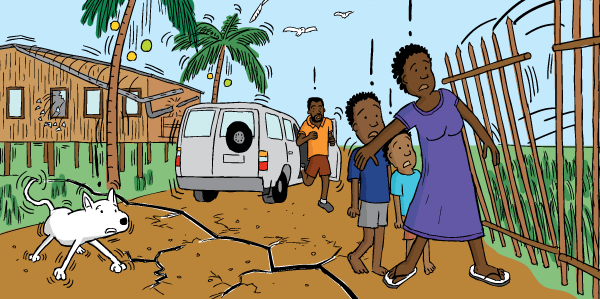Geoscience Australia natural hazards booklets
In 2013 Geoscience Australia commissioned me to illustrate some booklets they were preparing about natural hazards. Specifically: volcanoes, earthquakes and tsunami. This was a joint project with geological agencies in Papua New Guinea, with the booklets to be distributed to local PNG communities – especially volcanically-active towns like Rabaul, East New Britain.
Capturing the look of Papua New Guinea
One key aspect of the project was the need for the illustrations to be relevant for the local Papua New Guinea communities. Geoscience Australia had previously tried to engage local artists from PNG to illustrate the booklets, but nothing could be confirmed.
Armed with a stack of reference photos of the Rabaul township, its people, and the Tavurvur volcano, I began drawing scenes. I think I succeeded in capturing the ‘look’ of the local Papua New Guineans – their physical features, and styles of clothing. As well as the style of buildings and vegetation that fill their towns. Geoscience Australia was also glad to see small details I included in the illustrations, such as dogs wandering the streets, and kids playing footy on the beach (rugby league is almost the national religion of PNG!)

Showing the damage of natural hazards
I was determined not to shy away from the risky reality of natural hazards. Too often government agencies sanitise their publications, and only show images of “happy citizens doing exactly what they have been told to do” in emergencies.
This is the deluded work of public servants who have forgotten that real people don’t always behave as they ought to. Sanitised booklets with ‘everything going to plan’ during evacuations is a sure-fire way to make your readers disengage from your publication.
By contrast, I included images of people at risk of being crushed by falling debris…

…a sister having to drag her curious brother away from the beach, as a drawback drains away the water…

…and a lingering beach-goer at risk of being swept up by the tsunami.

My belief is that dramatic, eye-catching scenes like these are more likely to attract readers’ attention. Readers will read the information to learn how to avoid being the people at risk of being harmed.
The final products
I supplied uncoloured line art drawings to Geoscience Australia, whose in-house graphics team completed the colouring. (See below for comparisons between the black and white and coloured illustrations).
Geoscience Australia did a great job with the design of the booklets, which are extremely attractive and easy to read. A combination of short, clear sentences, as well as good typographic design. See the PDFs.

I was glad to see that my illustrations were given full-pages within the booklets. Rather than tucked away as small ‘figures’ inside a text-heavy booklet. I think the cartoons really accentuate the message of the text, and should make the concepts easy to understand.
The booklets have been sent to Papua New Guinea. Hopefully the locals can use them to formulate plans to survive earthquakes, volcanoes, and tsunamis.

Testimonial from Geoscience Australia project member
Stuart McMillen is organised, professional, and easy to work with. While working on our project, he completed all the tasks before deadline and I never had to worry about the job getting done. He had very good communication and kept me informed every step of the way. His illustrations well exceeded my expectations and our stakeholders are impressed by how the images are fun, interesting and factually correct.
— Libby Metz, Landslide Scientist, Geoscience Australia
- Download PDF copies of the booklets and posters from the Geoscience Australia website.
- Read a Geoscience Australia media release about the natural hazards materials. [21 Dec 2013]
- See also the animation which accompanied these natural hazards booklets.
























Comments